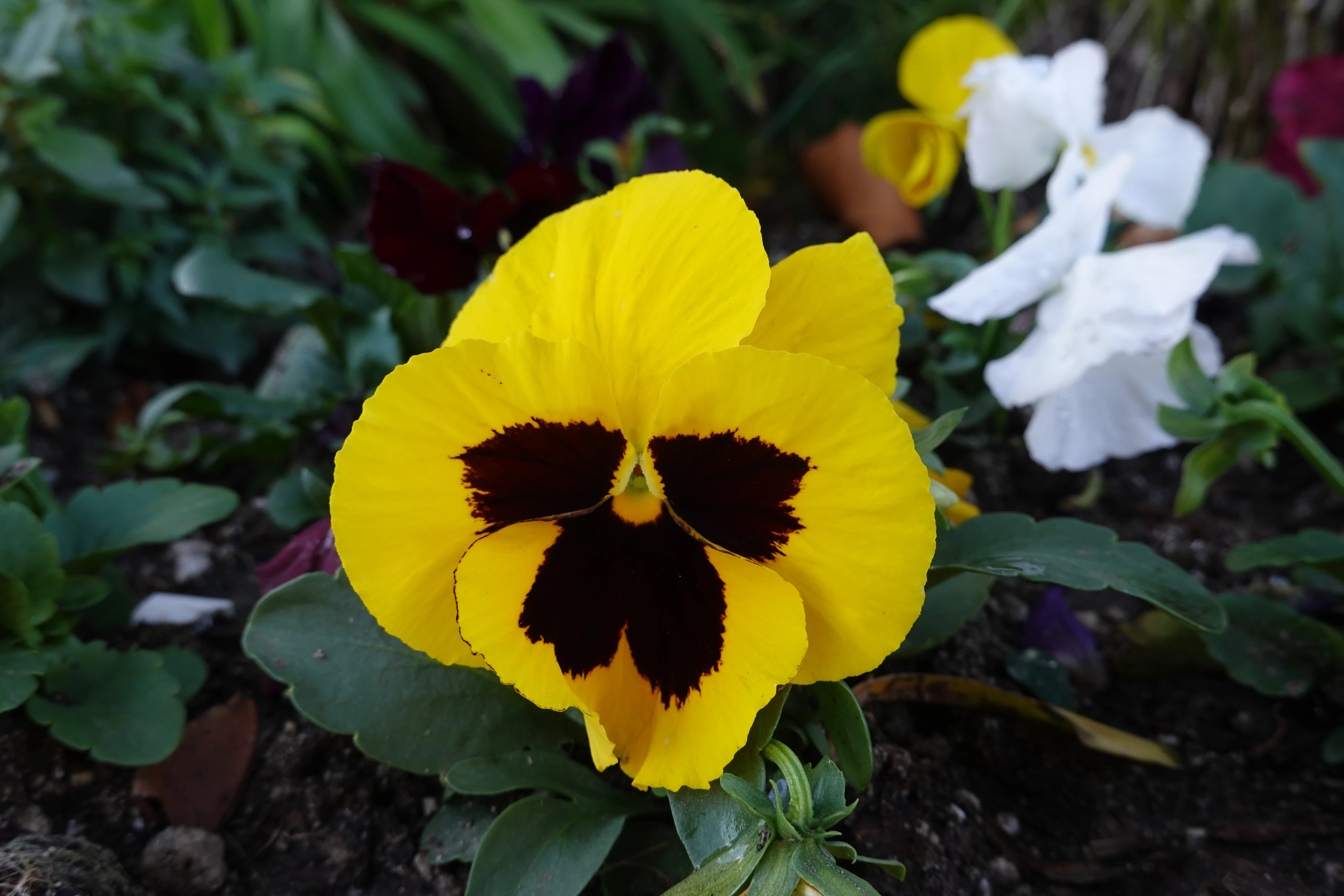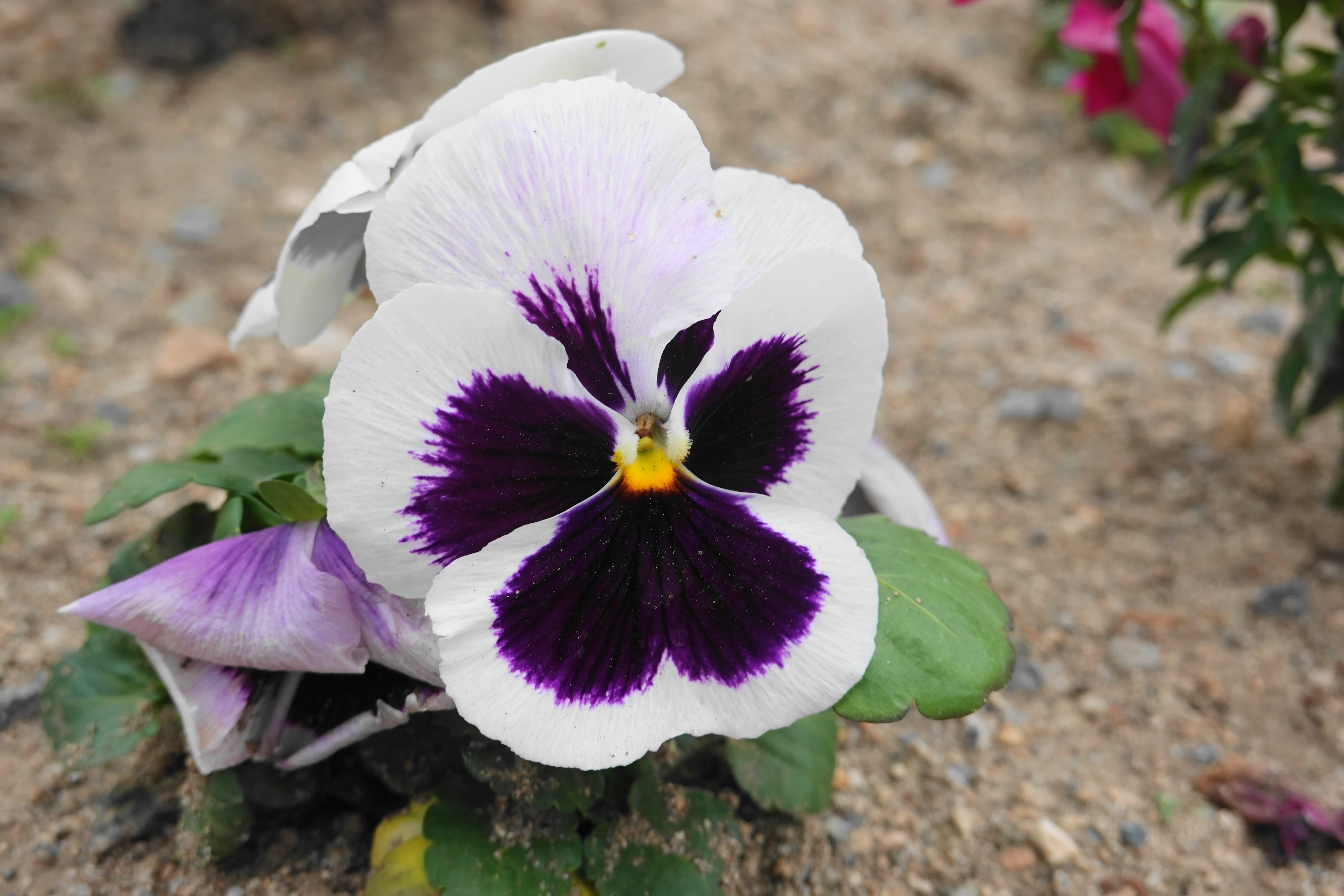The garden pansy (V. wittrockiana) is a hybrid of the wild pansy and the species V. lutea and V. altaica. It is also called ladies’-delight or stepmother’s flower. They are perennial, but normally grown as biennials or annuals because of their leggy growth. Modern horticulturists have developed a wide range of pansy flower colors and bicolors including yellow, gold, orange, purple, violet, red, white, and even near-black (very dark purple). Pansies typically display large showy face markings.
大花三色堇(V. wittrockiana)是三色堇和黄堇菜(V. lutea)和阿爾泰堇菜(V. altaica)的雜交種。它也被稱為淑女之花或繼母之花。它們是多年生植物,但由於可以長時間生長,通常每兩年或一年生一次。現代園藝家已經開發出多種色的三色堇花顏色和雙色,包括黃色,金色,橙色,紫色,紫色,紅色,白色,甚至接近黑色(非常深紫色)。大花三色堇通常會顯示出艷麗的臉部標記。
Photo Date: 2021.01.18, 2021.02.09 Location: LA County








Notes 筆記
- English common names, such as “pansy”, “viola” and “violet” may be used interchangeably.
- The name “pansy” is derived from the French word pensée, “thought”, as the flower was regarded as a symbol of remembrance.
- In Italy the pansy is known as flammola (little flame).
- The wild pansy (Viola tricolor) is native to cool parts of Europe but has been widely naturalized in North America. Old folk names for this pansy are johnny-jump-up, heartsease, and love-in-idleness.
- The garden pansy (V. wittrockiana) is a hybrid of the wild pansy and the species V. lutea and V. altaica. It is also called ladies’-delight or stepmother’s flower.
- Modern horticulturists have developed a wide range of pansy flower colors and bicolors including yellow, gold, orange, purple, violet, red, white, and even near-black (very dark purple). Pansies typically display large showy face markings.
- Pansies grow well in sunny or partially sunny positions in well-draining soils. They are perennial, but normally grown as biennials or annuals because of their leggy growth.
- Pansies are winter hardy in zones 4–8. They can survive light freezes and short periods of snow cover.
- Several fun facts about pansies according to a Homes & Gardens post:
- Pansies are edible. Their blossoms are a go-to edible flower for cake decorating and cocktail garnishes.
- Pansies are a symbol of love and affectionate thoughts. In Shakespeare’s A Midsummer Night’s Dream, the juice of a pansy was used in a love potion. In Victorian England, people gave these flowers to each other to express romantic feelings.
- The flowers from pansy varieties come in one of three color patterns: single colors without patterns; black lines radiating from the center; dark splotches from the center create a face-like appearance.
- Some varieties are known for their pleasant fragrance, while others don’t have a noticeable scent at all.
- February’s birth flower Is the pansy.
- 英文通用名稱,例如 “三色堇 pansy”,“堇菜 viola” 和 “紫羅蘭 violet” 可以互換使用。
- “大花三色堇”的名稱源自法語單詞 “penthée”(“ 心思”),因為該花被視為紀念的象徵。
- 在意大利,大花三色堇被稱為 flammola(小火焰)。
- 三色堇(Viola tricolor)原產於歐洲涼爽的地區,但已廣泛移植到北美。這種三色堇的舊俗稱是野生三色紫羅蘭 (johnny-jump-up),三色瑾(heartsease) 和三色紫羅蘭 (love-in-idleness)。
- 大花三色堇(V. wittrockiana)是三色堇和黄堇菜(V. lutea)和阿爾泰堇菜(V. altaica)的雜交種。它也被稱為淑女之花或繼母之花。
- 現代園藝家已經開發出多種色的三色堇花顏色和雙色,包括黃色,金色,橙色,紫色,紫色,紅色,白色,甚至接近黑色(非常深紫色)。大花三色堇通常會顯示出艷麗的臉部標記。
- 大花三色堇在排水良好的土壤,陽光充足或部分陽光充足的地方生長良好。它們是多年生植物,但由於可以長時間生長,通常每兩年或一年生一次。
- 三色堇在 4-8 區是耐寒的。它們可以抵抗輕微的冰凍和短時間的積雪。
- 根據“家庭與花園”網站的一篇文章,關於大花三色堇的一些趣聞:
- 大花三色堇是可食用的。它們的花朵是蛋糕裝飾和雞尾酒裝飾的首選食用花卉。
- 大花三色堇是愛和深情思想的象徵。在莎士比亞的《仲夏夜之夢》中,三色堇的汁用於愛情藥水。在維多利亞時代的英格蘭,人們互相獻出這些鮮花來表達浪漫的感覺。
- 大花三色堇品種的花朵具有以下三種顏色模式:單色無圖案;從中心放射出黑線;中心的深色斑點形成了類似臉的模樣。
- 有些品種以其宜人的香味而聞名,而另一些則根本沒有明顯的氣味。
- 二月的出生花是大花三色堇。
References 參考資料
- Wikipedia: Pansy
- Better Homes & Gardens: 5 Surprising Facts About Pansies You Probably Didn't Know
- 維基百科: 大花三色堇
Plants Posts 植物的帖子
Comments